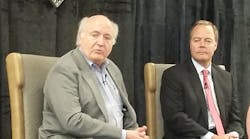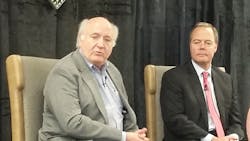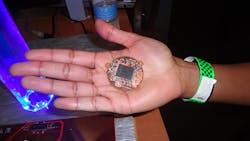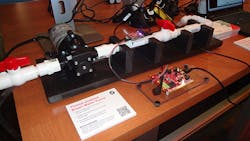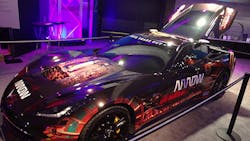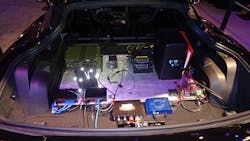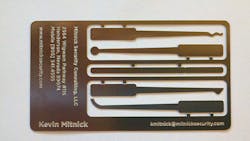The Freescale Technology Forum will be wrapping up soon. Freescale CEO Gregg Lowe gave the opening keynote, with Steve Wozniak hosting another this morning. Lowe, along with NXP’s CEO Richard Clemmer (Fig. 1) answered questions regarding the forthcoming Freescale/NXP merger. It looks to be rather complementary, with the microcontroller space having the most overlap. On the plus side, both adopted ARM cores, so managing this mix will likely be less of a challenge than was the case with Renesas, where there were a number of different architectures to support.
As with most shows, this has more to cover than what will fit into a single article (See "Gallery: Threading FTF 2015") but here are a couple of highlights. The Internet of Tomorrow was the tag line, but as a friend of mine put it, “Tomorrow never comes and we want it today.” This obviously was a play on the Internet of Things (IoT), and the IoT moniker was flouted seemingly on every other booth in the Tech Lab. Luckily there was enough real IoT stuff at the show from Freescale, NXP (they had a presence on the Tech Lab floor, too),and their partners.
Freescale had a number of announcements: The new i.MX 6Dual SCM (single chip module) mixes an SoC with DRAM and SPI flash via a multichip carrier (Fig. 2). This is a nice chip that combines a dual core, ARM Cortex-A9 system on-chip (SoC) with 16 Mbytes of SPI NOR flash memory and 1 or 2 Gbytes of LPDDR2 memory. It has a graphics engine that supports 2D and 3D multimedia, 1080p30 encode and decode for streaming media, an image processing unit (IPU), and display and camera input. It can handle both HDMI and LVDS displays, as well as 20-bit CSI (camera serial interface) and MIPI interfaces.
One key point of the IoT discussion was security. One of the most impressive offerings on display was Green Hills Software’s Device Lifecycle Management (DLM) System, which has end-to-end FIPS 140-2 compliant, Suite-B, cryptographic library support. End-to-end support starts with the end nodes and goes through the cloud, where PKI management comes into play. We are talking environments of thousands or millions of devices.
The IoT stacks were out in force, including Thread from The Thread Group. Among the demos was a pair of nodes in a Smart Water Pump (Fig. 3). The liquid flow was actually tracked by the vibration detected using accelerometers. The status was shipped out via Thread, so the status was being show all around the Tech Lab.
Arrow was showing a car (Fig. 4) that Sam Schmidt drove at 107 miles/hr. This might not be big news for an Indy Car driver, except Sam was paralyzed in a race crash and never thought he would drive again. When Arrow approached him about the project, his only requirement was that the car had to go faster than 100 miles/hr.
The back of the 2014 C7 Corvette Stingray holds most of the electronics controlling the car and processing the input from the sensors that are connected to the driver (Fig. 5). The Arrow Semi-Autonomous Motorcar (SAM) Project car is controlled by sensors that detect movement (Fig. 6). There are four infrared sensors mounted on the hat that are tracked by infrared cameras, detect head tilt motions for steering. A sip/puff system using breath control handles acceleration and braking. GPS tracking keeps the car at least 1.5 meters from the edge of the track.
FTF attendees were able to try out the system (Fig. 6). It is a bit harder to work than you might think, but it works quite well.
I wanted to close with a note about another person who was present at Gregg’s main keynote. This was Hackers may recall Kevin Mitnick’s name; look it up if you don’t know, or check out mitnicksecurity.com. Kevin has an interesting business card (Fig. 7) that a few lucky people got their hands on. It may be less practical these days, what with more locks being computerized, but it is the thought that counts.
Time to catch a plane, so more later.
